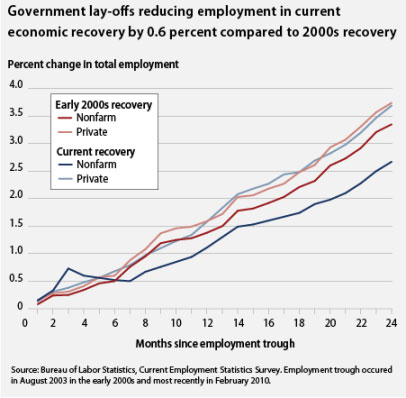The current economic recovery is going well if one looks at private sector job creation. The pace of private sector job creation is slower than in the recovery from the early 1990s recession, but it’s about the same as it was during the economic recovery in the early 2000s. In the first two years of both the current and early 2000s recovery, employment grew by 3.7 percent.
But since early 2009, governments at all levels have shed nearly 700,000 jobs, most of them at the state and local level. Since August of 2008 state and local governments have shed a total of 647,000 workers, of which 64 percent, or 416,000, were women workers.
When we compare total employment between the current and early 2000s recovery, the loss of public sector jobs pops out: Employment growth is 0.6 percent lower in this recovery than it would have been had government chosen not to hand out so many pink slips.

Last month there were 6,000 government layoffs, a much smaller number than in recent months, but still a drag on the recovery. And the crazy thing is that while policymakers cannot control the actions of private employers, they do control how much they add to the nation’s unemployment woes via government layoffs. Laying off teachers and police-officers as the nation struggles to get back to full employment is the wrong policy at the wrong time.
Join us in defending the truth before it’s too late
The future of independent journalism is uncertain, and the consequences of losing it are too grave to ignore. To ensure Truthout remains safe, strong, and free, we need to raise $27,000 in the next 24 hours. Every dollar raised goes directly toward the costs of producing news you can trust.
Please give what you can — because by supporting us with a tax-deductible donation, you’re not just preserving a source of news, you’re helping to safeguard what’s left of our democracy.